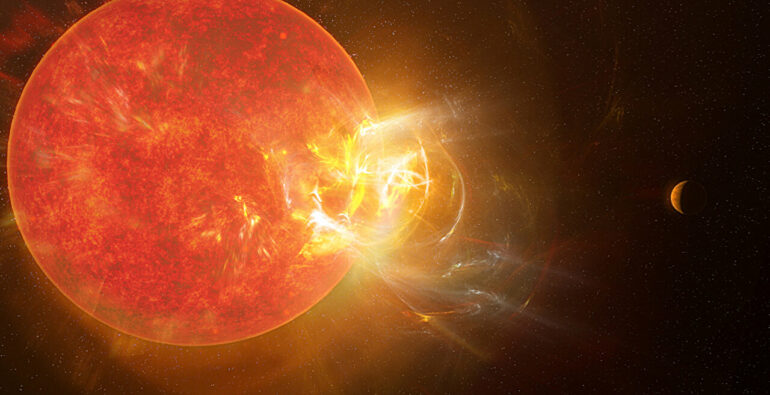At a distance of just over four light years, Proxima Centauri is our nearest stellar neighbor and is known to be a very active M dwarf star. Its flare activity has been well-known to astronomers using visible wavelengths of light, but a new study using observations with the Atacama Large Millimeter/submillimeter Array (ALMA) array highlights this star’s extreme activity in radio and millimeter wavelengths, offering exciting insights about the particle nature of these flares as well as potential impacts to the livability of its terrestrial, habitable-zone planets.
Known to host a potentially habitable planet, the star Proxima Centauri exhibits very active flare activity in optical wavelengths. Similar to flares on our sun, these outbursts release light energy across the electromagnetic spectrum as well as bursts of particles known as stellar energetic particles. Depending on the energy and frequency of these flares, nearby planets in the habitable zone might be rendered uninhabitable as the flares strip planetary atmospheres of necessary ingredients such as ozone and water.
A team of astronomers, led by Kiana Burton of the University of Colorado and Meredith MacGregor of Johns Hopkins University, utilized archival data and new ALMA observations to study the millimeter-wavelength flare activity of Proxima Centauri. Their study is published in The Astrophysical Journal.
Proxima Centauri’s small size and strong magnetic field indicate that its entire internal structure is likely convective—unlike the sun, which has both convective and nonconvective layers. As a result, the star is much more active. Its magnetic fields become twisted, develop tension, and eventually snap, sending streams of energy and particles outward in what astronomers observe as flares.
MacGregor summarized the study’s core question, “Our sun’s activity doesn’t remove Earth’s atmosphere and instead causes beautiful auroras, because we have a thick atmosphere and a strong magnetic field to protect our planet. But Proxima Centauri’s flares are much more powerful, and we know it has rocky planets in the habitable zone.
“What are these flares doing to their atmospheres? Is there such a large flux of radiation and particles that the atmosphere is getting chemically modified, or perhaps completely eroded?”
This research represents the first multi-wavelength study using millimeter observations to uncover a new look at the physics of flares. Combining 50 hours of ALMA observations using both the full 12-meter array as well as the 7-meter Atacama Compact Array, a total of 463 flare events were reported at energies ranging from 1024 to 1027 erg. The flares themselves were short events, ranging from 3 to 16 seconds.
“When we see the flares with ALMA, what we’re seeing is the electromagnetic radiation—the light in various wavelengths. But looking deeper, this radio wavelength flaring is also giving us a way to trace the properties of those particles and get a handle on what is being released from the star,” says MacGregor.
To do so, astronomers characterize the star’s so-called flare frequency distribution in order to map out the number of flares as a function of their energy. Typically, the slope of this distribution tends to follow a power law function: smaller (less energetic) flares occur more frequently while larger, more energetic flares occur less frequently.
Discover the latest in science, tech, and space with over 100,000 subscribers who rely on Phys.org for daily insights.
Sign up for our free newsletter and get updates on breakthroughs,
innovations, and research that matter—daily or weekly.
Proxima Centauri experiences so many flares that the team detected many flares within each energy range. Furthermore, the team was able to quantify the asymmetry of the star’s highest energy flares, describing how the flares’ decay phase was much longer than the initial burst phase.
Radio- and millimeter-wavelength observations help to put constraints on the energies associated with these flares and their associated particles. MacGregor highlighted ALMA’s key role: “The millimeter flaring seems to be much more frequent—it’s a different power law than we see at the optical wavelengths. So if we only look in optical wavelengths, we’re missing critical information. ALMA is the only millimeter interferometer sensitive enough for these measurements.”
More information:
Kiana Burton et al, The Proxima Centauri Campaign—First Constraints on Millimeter Flare Rates from ALMA, The Astrophysical Journal (2025). DOI: 10.3847/1538-4357/ada5f2
Provided by
National Radio Astronomy Observatory
Citation:
Small star, mighty flares: ALMA shares new view of Proxima Centauri (2025, March 27)



